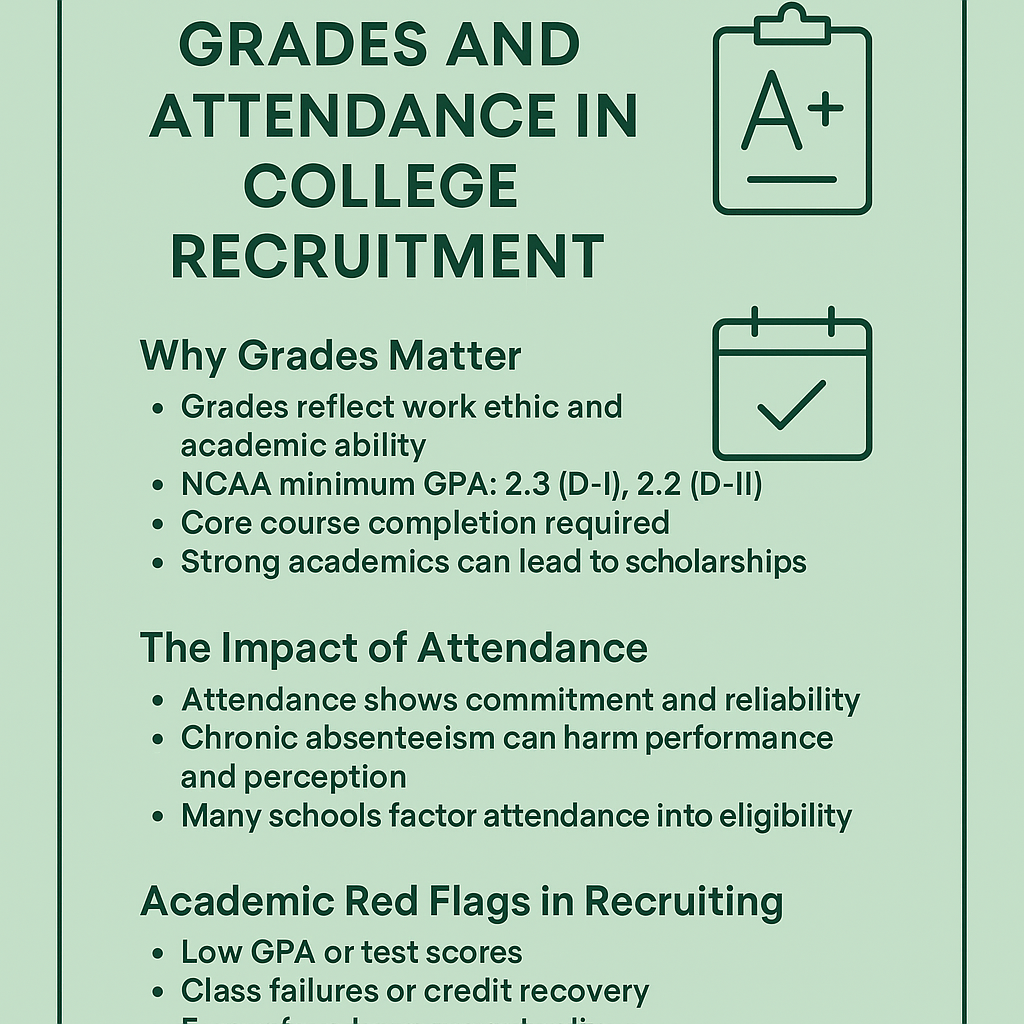Introduction
For student-athletes dreaming of playing at the collegiate level, athletic performance is only part of the equation. Academic achievement—specifically grades and attendance—plays a critical role in college recruitment. Coaches and recruiters are increasingly emphasizing academics, not just for eligibility purposes but as an indicator of discipline, responsibility, and long-term success (Brown & Conroy, 2023).
1. Why Grades Matter
Grades reflect more than just knowledge—they demonstrate work ethic, time management, and the ability to handle pressure. According to the NCAA (2024), student-athletes must meet minimum GPA requirements and standardized test benchmarks to be eligible for collegiate sports.
- GPA Requirements: Division I athletes need at least a 2.3 GPA, while Division II requires a minimum 2.2 (NCAA, 2024).
- Core Course Completion: The NCAA Eligibility Center mandates the completion of 16 core academic courses (NCAA, 2024).
- Strong academics can also open doors to academic scholarships, honors programs, and greater flexibility in college selection (Martin, 2023).
2. The Impact of Attendance
Consistent attendance is equally important. Regular school attendance builds habits of commitment and accountability—traits that coaches look for when assessing recruits (Smith, 2022). Chronic absenteeism can lead to poor academic performance and suggests unreliability, which may deter college scouts (Education Week, 2023). Moreover, many schools factor attendance into eligibility for sports participation, further linking it to recruitment opportunities (Johnson, 2024).
3. Academic Red Flags in Recruiting
Coaches have limited scholarships and roster spots—they can’t afford to invest in athletes who may not qualify academically. Some common academic red flags that harm recruitment include:
- Low GPA or poor standardized test scores
- Repeated class failures or credit recovery issues
- Excessive absences or tardiness
- Inability to balance academics and athletics (Brown & Conroy, 2023)
These issues can lead to recruitment interest drying up, even for athletically gifted players (Johnson, 2024).
4. How to Stay on Track
To stay competitive in recruitment, student-athletes should:
- Maintain a strong GPA: Aim for higher than the minimum required. Many top programs prefer GPAs of 3.0 or higher (NCAA, 2024).
- Attend school consistently: Show commitment not only on the field but in the classroom.
- Seek academic support: Use tutoring services, study groups, and time management tools.
- Communicate with coaches: Many recruiters want updates on academic standing as much as athletic highlights (Smith, 2022).
5. Long-Term Benefits
Even for athletes who may not pursue professional sports, a solid academic record sets the stage for career success beyond athletics. Academic excellence ensures eligibility, opens scholarship opportunities, and provides a safety net for life after sports (Martin, 2023).
Conclusion
Athletic talent may get a student noticed, but academics seal the deal. Grades and attendance demonstrate responsibility, dedication, and readiness for the challenges of college athletics and academics. For student-athletes aiming for college recruitment, excelling in the classroom is just as essential as performing on the field.
References
Brown, L., & Conroy, M. (2023). Balancing academics and athletics: How grades impact college recruitment. Journal of Sports Education, 12(2), 45–53.
Education Week. (2023). Chronic absenteeism threatens student success—and college eligibility. Retrieved from https://www.edweek.org
Johnson, P. (2024). What college coaches look for beyond athletic ability. Athletic Recruiting Network, 8(1), 10–15.
Martin, S. (2023). The role of academic achievement in scholarship decisions for student-athletes. College Access Review, 17(4), 66–72.
NCAA. (2024). Academic eligibility requirements for student-athletes. Retrieved from https://www.ncaa.org/student-athletes/future
Smith, J. (2022). Attendance, attitude, and academic performance in student-athlete recruitment. High School Sports Journal, 9(3), 21–28.



Comments ()